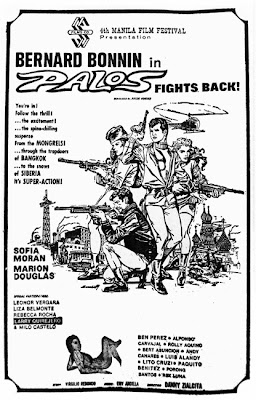Hailed by fans and critics as Nora Aunor's finest movie and one of Direk Ishmael Bernal's best work. But for this film, Nora received only one Best Actress Award, from the MMFF (Metro Manila Film Festival), and one nomination from the FAP (Film Academy of the Philippines). A decade later, the Manunuri ng Pelikulang Pilipino included Himala in its list of the 10 Best films of the decade (1980-89). After twenty five years, the wait is over. It's finally released on DVD. Buy your original copy now!

 Himala (1982)
Himala (1982)
Himala Revisited
by Arnel Resma Ramos
Watching Ishmael Bernal's landmark film Himala on a lethargic afternoon is like revisiting an old familiar haunt. It brings back memories of a cherished time when locally manufactured movies made one ponder and contemplate, think and analyze.
We were but a boy in knee pants, starry-eyed and unsophisticated, when we first saw this meditative piece on faith and the evils that it brings forth when used for the wrong reasons. The year was 1982, exactly two decades ago, and we well remember being enthralled by the sheer force of its powerful images and quietly devastating performances. We are one of the blessed few who own a video tape copy of the film that has remained, through the years, Nora Aunor's signature film. The pint-sized superstar delivered a miracle of a performance as Elsa, the false visionary. Perhaps, the finest performance by a Filipino actor ever recorded on celluloid. If the diminutive multimedia luminary ever decides to leave the movies for good, Himala is enough reason to guarantee her of immortality.
Set in a far-flung barrio, a lowly, plain looking lass claims that the Virgin Mary appeared before her during an eclipse. She becomes a faith healer and almost overnight the sleepy town transforms into a bustling community. Pilgrims and tourists troop to Barrio Cupang out of curiosity while the sick flock to the once-cursed place with the hope that the miracle will heal them. Among the people who gravitate around Elsa are her two fanatic followers: a childhood friend named Chayong, almost saintly in countenance, and a poor woman (played with serene intensity by theater stalwart Amable Quiambao) who places her devotion to Elsa on top of her priority list. Two other important characters come within Elsa's orbit: a struggling documentary film director who treats his camera as his God and a downtrodden prostitute (performed to perfection by Gigi Duenas).
Eventually, the miracle brings out the worst in the townsfolk. The greedy use it for their selfish motives. They peddle Elsa's miracle like a commodity, to the extent of selling bottles of supposedly miraculous water. The politicians take advantage of the media mileage to further their hidden agenda. The dire poverty drives the women to prostitution and the men to committing crime to escape their miserable plight.
Then one day, Elsa loses her power to cure. The faithful Chayong takes her own life and once more Barrio Cupang goes back to being barren and seemingly God-forsaken. There is an interesting twist as to why this happens. I choose not to reveal it so as not to spoil your viewing pleasure, if and when you come across a copy of this film and like me, be held captive by its hypnotic quality. I dare say that Himala is far more spiritual than the countless movies inspired by the lives of saints.
The film concludes in a scene where Elsa, following the rain that has come to Barrio Cupang after a long drought, gathers her believers in the sand dunes and announces, to everyone's shock, that indeed the miracle is nothing but a hoax. It is in this scene where Nora delivers the iconic lines "Walang himala, ang himala ay nasa ating puso (There is no miracle, the miracle is in our hearts)." Right after the startling revelation, Elsa is gunned down and pandemonium breaks out.
The film is not the typical fare that the average Filipino moviegoer laps up with glee. There are no violent confrontation scenes. Missing too is the element of sex. But the film is unerring in its depiction of the grim consequences when people use faith to advance themselves. From the first scene to the last, Bernal never loses grip on his material, imbuing it with directorial touches that may go unnoticed by undiscerning viewers. They may find the film too passive and gloomy. Bernal executes the film according to his grand design. The cinematography and the editing are laudable.
Ricky Lee's script is deft and soulful. Some quarters complain that the main problem with the script is the underwritten part of the central character Elsa. We feel that the role was decidedly underwritten to make the part properly enigmatic and mystical, in keeping with the elusive quality of the film. After all, faith is a very personal matter. It is not something that one slaps right in the face of others.
Then until now, we believe that Nora Aunor should have swept all the best actress awards for that particular year. She was pitted against Vilma Santos' heartfelt portrayal of the mistress in Relasyon and the latter scored a grandslam. This is not to belittle Santos' portrayal but if one were to be objective, it would be easy to see that Aunor had the more complex role and only an actress of her caliber can pull off the part with much persuasion. It calls for a restrained, self-effacing acting style. And Aunor, the consummate actress that she was (take note that we used the past tense because the more recent film outings of the actress are far from her best. She has become very florid, like a bad version of a hysterical Charito Solis), strikes not a false note in her performance. It is, in one word, mesmerizing. And Himala is without a scintilla of a doubt the pinnacle of her cinematic achievements.
Films like Himala reaffirm our faith in Philippine movies. We hope that despite the fact that two of our most revered directors, Bernal and Lino Brocka, have long since gone to the great beyond, people in this well-loved industry will join hands and strive to come up with films that will herald a renaissance in Philippine cinema. We hope to see the day when the Philippines will finally be able to make it as a nominee in the Oscar Best Foreign Language Film category. Some cynics may say that it is wishful thinking but call us what you wish, we remain undaunted in our belief that Philippine Cinema is at par with the best of the world. see link
 Kosme the cop (retired), a daily cartoon strip by Malang appeared regularly at the Manila Chronicle in the 1950s. Its about the henpecked husband who gets into all sorts of troubles, particularly from his nagging wife. It's Kosme celebrating the coming of the New Year. Enjoy the humor of the 1950s!!!
Kosme the cop (retired), a daily cartoon strip by Malang appeared regularly at the Manila Chronicle in the 1950s. Its about the henpecked husband who gets into all sorts of troubles, particularly from his nagging wife. It's Kosme celebrating the coming of the New Year. Enjoy the humor of the 1950s!!!

















































